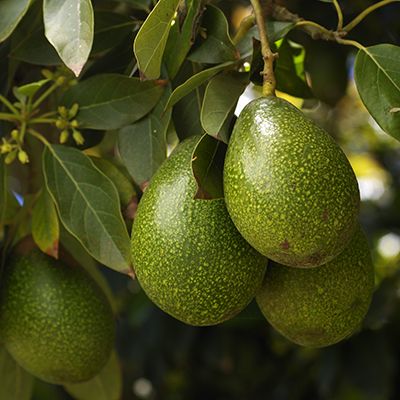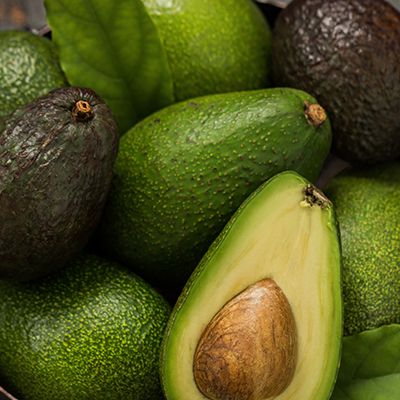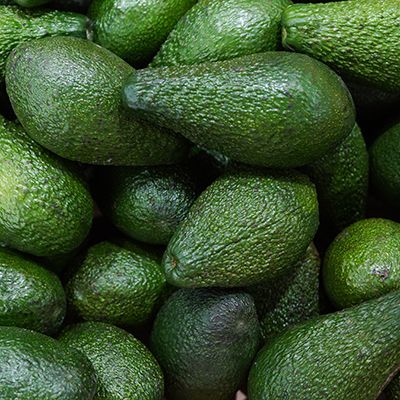


Avocado Care Guide
Avocados probably originated in southern Mexico. In the Bay area, they will grow where temperatures do not fall much below freezing. They will grow in shade and between buildings but are productive only in full sun. The roots are highly competitive and will choke out nearby plants. The coarse, greedy roots will raise pavement with age. The Avocado is a dense evergreen tree, shedding many leaves in early spring. In a Bay Area garden allow at least 20 feet for the mature tree. A grafted plant normally produces fruit within one or two years compared to eight to 20 years for seedlings.
Avocados grow well on a wide range of soil types but a medium-textured soil is best. Trees should not be planted in hardpan or clay subsoil unless provided with adequate drainage because these soils accumulate subsurface water which restricts root activity and favors root or crown rot. When transplanting an avocado tree into typical heavy peninsula clay soil, dig the hole at least three times the diameter of its container, but no deeper than the soil in the container. Set this native soil aside and mix in one-third compost (Master Nursery® Gold Rush or similar). Place one inch of this soil mix plus about four tablespoons of Master Nursery® Master Start in the bottom of the hole. Mix the soil and fertilizer thoroughly and press firmly into place. Add another four tablespoons of Master Nursery® Master Start to the remaining soil mix and combine thoroughly. Carefully remove the avocado tree from its container and stand it in the middle of hole. Add the remaining soil mix and press firmly around the root ball. The root ball should be one-half to one inch above the soil level. The excess soil mix is used to build a low berm around the tree at the perimeter of the original hole. Water thoroughly.
Dwarf avocados (Gwen or Little Cado) should be planted in containers at least the size of a half wine barrel, using Gardner & Bloome® Organic Potting Soil.
Do not fertilize the plants during the first year in their new environment. After one year of growth, use a balanced fertilizer containing zinc such as Master Nursery® Fruit Tree and Vine Food. Apply the fertilizer three times a year (Valentine’s Day, Memorial Day and Labor Day) in the amount listed on the package. Plants in containers should be fertilized monthly (about three tablespoons).
Irrigate the newly planted tree for about half an hour, once a week. Before irrigating during the third week, check the soil for moisture at the 12”-16” level. You may have to use a soil probe or dig a hole to check for moisture. If the soil is dry, increase the irrigation, but if the soil is moist, wait another week before watering the tree. The berm should hold the water at about the drip line of the tree. As the tree grows, the berm will have to be moved out.
Avocado flowers appear in January. Some varieties shed pollen in the afternoon and can only be pollinated in the morning (type A) while others shed pollen in the morning and can only be pollinated in the afternoon (type B). A single avocado tree will bear fruit but will be more productive if both type A and B varieties are present.
The varieties “Mexicola” and “Mexicola Grande” are type A which are the hardiest, most resistant to low temperatures. The variety “Bacon” is a type B and is also hardy for the Bay Area.
Pest and Disease: Rats and squirrels will strip off the fruit. Leaf rolling caterpillars may destroy branch terminals. Brown mites and six-spotted mites can be controlled with sulfur sprays. Two fungi and one virus cause more damage than any of these pests. Dothiorella canker fungus infects the trunk and causes dead patches. Its primary symptom is a white powder which oozes from the bark. The most serious disease is root rot caused by Phytophthora fungus. It is most common and severe in constantly wet and poorly drained soils.
Sun blotch is a viral disease that causes yellow streaking of young stems and mottling and crinkling of new leaves. Less common but other possible diseases are Verticillium Wilt and Armillaria Root Rot.